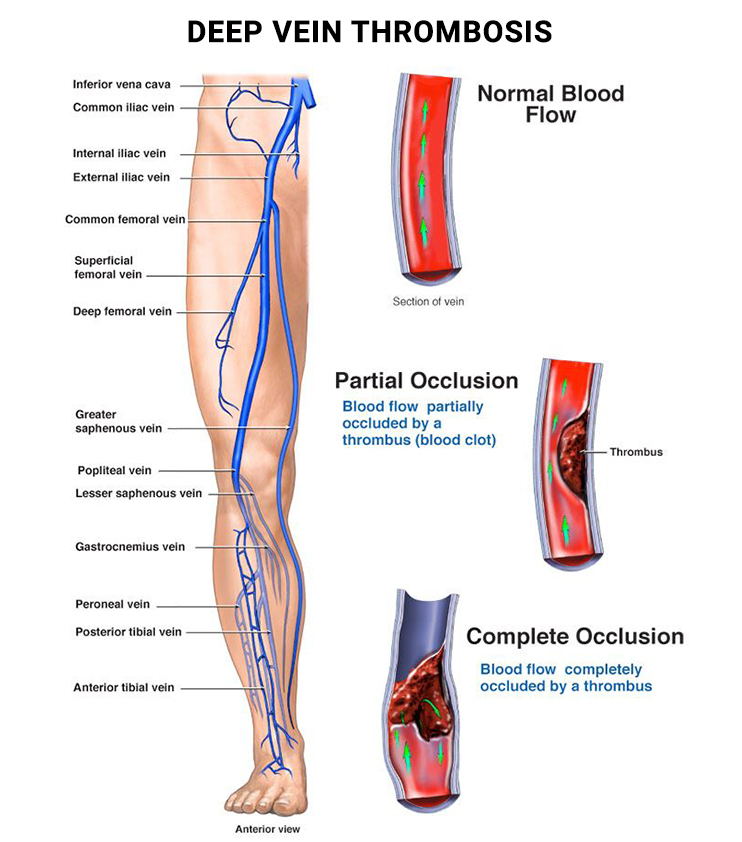

While a blood clot may take time to form in the leg, the symptoms usually come on suddenly once it reaches deep in the veins. When you do develop DVT, technically called deep vein thrombosis, you must receive treatment as soon as possible to avoid possibly fatal complications. Find an expert level of vein treatment at the Vein Care Center. With offices in New York City’s Financial District, Greenwich Village and Midtown Manhattan, and Upper East Side, they can diagnose and treat DVT before it turns deadly. In New Jersey, seek care from the Vein Care Center experts in Englewood Cliffs, Paramus, Cranford, Riverdale or East Brunswick. Call today for a consultation.
Deep vein thrombosis (DVT) is a condition affecting the deeper veins in your body. This condition develops when a blood clot forms in one of the deeper veins, most commonly in the legs. DVT is part of a serious cardiovascular disease known as venous thromboembolism. According to the Centers for Disease Control and Prevention (CDC), 10 to 30 percent of Americans diagnosed with venous thromboembolism in the legs suffer fatal complications.
Veins transport blood from extremities back to the heart and lungs for oxygenation. The rapid flow of deoxygenated blood from the tissues to the heart completes the cycle of the body’s circulatory system. A blood clot not only restricts the uninterrupted flow of blood, but the clot can also break off and get stuck in the lungs, creating a potentially fatal pulmonary embolism.

At the center vein restoration in New York City and Northern New Jersey, the top-rated vein doctors, led by Dr. Jonathan Arad diagnose and treat a wide variety of vein conditions, including DVT and:
Visit the nearest Vein Care Center at the earliest opportunity if you start feeling symptoms of deep vein thrombosis. During your initial vein consultation, your vein specialist considers your symptoms, which may include:
If you’ve developed a pulmonary embolism, which is a much more dangerous condition, you may notice symptoms that include:
DVT develops when there’s a blockage in one of the veins, which most often occurs in the legs. Any physical problem or disease that leads to blood clot formation is a potential cause of DVT. Common causes include:
Before treatment can start, your vein doctor analyzes your symptoms and medical history. You may be asked to undergo tests to identify the underlying cause of the DVT. A firm diagnosis forms the basis of a successful and individual treatment of DVT.
While some risk factors are related to lifestyle factors, such as your weight or sports activities, other risks may be unavoidable. Common conditions that increase the risk of blood clotting in your deep veins include:
If you fall into one or more of these categories and you notice DVT symptoms, you’re wise to schedule a consultation. As part of the interventional treatment plans at the Vein Care Center, your vein doctor discusses these risk factors to help you avoid a recurrence of the condition.
"Overall, very satisfied with their work. I used to hide my legs because of the way they looked because they were covered with varicose veins but not anymore. I am not ashamed of my legs anymore.
Lita R.After you receive a diagnosis, your doctor determines the best treatment for DVT based on your symptoms, your age, any pre-existing medical conditions and other factors. Treatment goals include preventing recurrence of clots and preventing a pulmonary embolism. The doctors at the Vein Care Center always begin with the least invasive treatment options for deep vein thrombosis, which includes:
Treatment of DVT at an early stage prevents a potentially fatal pulmonary embolism from moving to your lungs. Dr. Arad and the other vein specialists use individualized treatment for vein conditions. By utilizing advanced medical technology, the team achieves high rates of success. Contact the vein doctors at any of their Manhattan locations or locations in Bergen County, Morris County and Union County, New Jersey for effective DVT treatment.